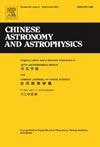Simulation on the Mechanism of Harmonic Maser Emission through the Wave Coalescence Process
Q4 Physics and Astronomy
引用次数: 0
Abstract
Electron Cyclotron Maser Emission (ECME) driven by electrons with loss-cone distribution is the main mechanism for explaining solar radio spikes. However, in strongly magnetized plasmas, the losscone-driven ECME mainly generates fundamental X mode emissions, which can be efficiently absorbed when escaping through the second-harmonic layer in the solar corona. To solve the "escaping difficulty", recent studies suggested a new mechanism of harmonic maser emission (X2) involving nonlinear wave coupling process of Z-mode and fundamental X-mode (X1) waves (Z+ZX2, Z+X1X2). It is necessary to verify the nonlinear wave coalescence process with theoretical analyses and numerical simulations. Here, the possibility of a nonlinear wave coupling process is examined via solving the matching conditions for three-wave resonant interaction based on the dispersion relation of cold plasma in magneto-ionic theory. The matching conditions for the Z and/or X1 waves were found to be satisfied over a wide range of parameters, leading to the production of X2 emissions that propagate perpendicularly and obliquely relative to the direction of the background magnetic field. Based on the solutions obtained in the matching condition analysis, we selected four sets of solutions of Z+Z and Z+X1 to perform particle-in-cell simulations using wave pumping method, to verify the nonlinear process of wave coalescence generating second harmonic X-mode emissions. With X1 and/or Z modes correctly pumped in the simulation domain, efficient generation of X2 emissions was observed, with saturation achieved within 400 . The conversion rate of energies of X2 emissions to Z mode waves varies from 2% to 8%. The study presents strong evidence to support the new mechanism of harmonic maser emission, which can be widely applied to explain the solar and space radio emissions.
波聚并过程中谐波脉泽发射机理的模拟
由损耗锥分布的电子驱动的电子回旋脉泽发射(ECME)是解释太阳射电尖峰的主要机制。然而,在强磁化等离子体中,损耗锥驱动的ECME主要产生基本的X模发射,当这些发射通过日冕的二次谐波层逸出时,可以被有效吸收。为了解决“逃逸困难”,最近的研究提出了一种新的谐波脉泽发射(X2)机制,涉及Z模和x基模(X1)波(Z+Z→X2, Z+X1→X2)的非线性波耦合过程。有必要通过理论分析和数值模拟对非线性波合并过程进行验证。本文基于磁离子理论中的冷等离子体色散关系,通过求解三波共振相互作用的匹配条件,考察了非线性波耦合过程的可能性。在很宽的参数范围内,Z波和/或X1波的匹配条件都得到了满足,从而产生了相对于背景磁场方向垂直和倾斜传播的X2发射。基于匹配条件分析得到的解,我们选择Z+Z和Z+X1四组解,采用波抽运方法进行粒子胞内模拟,验证波聚并产生二次谐波x模发射的非线性过程。通过在模拟域中正确泵送X1和/或Z模式,观察到有效产生X2排放,并在400 Ωce−1内达到饱和。X2发射能量到Z模波的转换率在2% ~ 8%之间。该研究为谐波脉泽发射的新机制提供了有力的证据,可广泛应用于解释太阳和空间射电发射。
本文章由计算机程序翻译,如有差异,请以英文原文为准。
求助全文
约1分钟内获得全文
求助全文
来源期刊

Chinese Astronomy and Astrophysics
Physics and Astronomy-Astronomy and Astrophysics
CiteScore
0.70
自引率
0.00%
发文量
20
期刊介绍:
The vigorous growth of astronomical and astrophysical science in China led to an increase in papers on astrophysics which Acta Astronomica Sinica could no longer absorb. Translations of papers from two new journals the Chinese Journal of Space Science and Acta Astrophysica Sinica are added to the translation of Acta Astronomica Sinica to form the new journal Chinese Astronomy and Astrophysics. Chinese Astronomy and Astrophysics brings English translations of notable articles to astronomers and astrophysicists outside China.
 求助内容:
求助内容: 应助结果提醒方式:
应助结果提醒方式:


